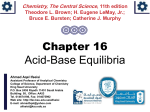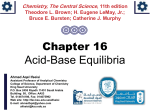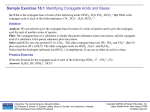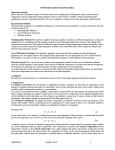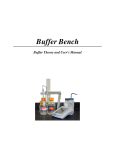Download Ch 16
Transcript
Chemistry, The Central Science, 11th edition Theodore L. Brown; H. Eugene LeMay, Jr.; Bruce E. Bursten; Catherine J. Murphy Chapter 16 Acid-Base Equilibria Ahmad Aqel Ifseisi Assistant Professor of Analytical Chemistry College of Science, Department of Chemistry King Saud University P.O. Box 2455 Riyadh 11541 Saudi Arabia Office: AA53 Tel. 014674198, Fax: 014675992 Web site: http://fac.ksu.edu.sa/aifseisi E-mail: [email protected] [email protected] Acids and bases are important in numerous chemical processes that occur around us – from industrial processes to biological ones, from reactions in the laboratory to those in our environment. The time required for a metal object immersed in water to corrode, the ability of an aquatic environment to support fish and plant life, the fate of pollutants washed out of the air by rain, and even the rates of reactions that maintain our lives all critically depend upon the acidity or basicity of solutions. Indeed, an enormous amount of chemistry can be understood in terms of acid-base reactions. 16.1 Acids and Bases: A Brief Review From the earliest days of experimental chemistry, scientists have recognized acids and bases by their characteristic properties. Acids have a sour taste and cause certain dyes to change color (for example, litmus turns red on contact with acids). Indeed, the word acid comes from the Latin word acidus, meaning sour or tart. Bases, in contrast, have a bitter taste and feel slippery (soap is a good example). The word base comes from an old English meaning of the word, which is “to bring low”. (we still use the word debase in this sense, meaning to lower the value of something). When bases are added to acids, they lower the amount of acid. Indeed, when acids and bases are mixed in certain proportions, their characteristic properties disappear altogether. Historically, chemists have sought to relate the properties of acids and bases to their compositions and molecular structures. By 1830 it was evident that all acids contain hydrogen but not all hydrogen-containing substances are acids. During the 1880s, the Swedish chemist Svante Arrhenius (1859-1927) linked acid behavior with the presence of H+ ions and base behavior with the presence of OH- ions in aqueous solution. Arrhenius Definition An acid is a substance that, when dissolved in water, increases the concentration of hydrogen ions (H+). HCl(g) → H+(aq) + Cl-(aq) A base is a substance that, when dissolved in water, increases the concentration of hydroxide ions (OH-). NaOH(s) → Na+(aq) + OH-(aq) 16.2 Brønsted-Lowry Acids and Bases Brønsted-Lowry Definition The Arrhenius concept of acids and bases, while useful, has limitations. For one thing, it is restricted to aqueous solutions. Brønsted-Lowry concept is based on the fact that acid-base reactions involve the transfer of H+ ions from one substance to another. Brønsted-Lowry An acid is a proton donor. A base is a proton acceptor. When a proton is transferred from HCl to H2O, HCl acts as the Brønsted-Lowry acid and H2O acts as the Brønsted-Lowry base. What happens when an acid dissolves in water? Water acts as a Brønsted-Lowry base and abstracts a proton (H+) from the acid. As a result, the conjugate base of the acid and a hydronium ion are formed. An H+ ion is simply a proton with no surrounding valence electron. This small, positively charged particle interacts strongly with the nonbonding electron pairs. A Brønsted-Lowry acid… …must have a removable (acidic) proton A Brønsted-Lowry base… …must have a pair of nonbonding electrons Water molecules to form hydrated hydrogen ions. For example, the interaction of a proton with one water molecule forms the hydronium ion, H3O+(aq) Chemists use H+(aq) and H3O+(aq) interchangeably to represent the same thing – namely the hydrated proton that is responsible for the characteristic properties of aqueous solutions of acids. Because the emphasis in the Brønsted-Lowry concept is on proton transfer, the concept also applies to reactions that do not occur in aqueous solution. In the reaction between HCl and NH3, for example, a proton is transferred from the acid HCl to the base NH3. Lets consider another example that compares the relationship between the Arrhenius definition and the Brønsted-Lowry definitions of acids and bases – an aqueous solution of ammonia, in which the following equilibrium occurs: Ammonia is an Arrhenius base because adding it to water leads to an increase in the concentration of OH-(aq). It is a Brønsted-Lowry base because it accepts a proton from H2O. The H2O molecule in the equation acts as a Brønsted-Lowry acid because it donates a proton to the NH3 molecule. An acid and a base always work together to transfer a proton. In other words, a substance can function as an acid only if another substance simultaneously behaves as a base. To be a Brønsted-Lowry acid, a molecule or ion must have a hydrogen atom that it can lose as an H+ ion. To be a Brønsted-Lowry base, a molecule or ion must have a nonbonding pair of electrons that it can use to bind the H+ ion. Some substances can act as an acid in one reaction and as a base in another. For example, H2O is a Brønsted-Lowry base in its reaction with HCl and a Brønsted-Lowry acid in its reaction with NH3. a substance that is capable of acting as either an acid or a base is called amphiprotic. An amphiprotic substance acts as a base when combined with something more strongly acidic than itself and an acid when combined with something more strongly basic than itself. e.g., HCO3-, HSO4-, H2O Conjugate Acids and Bases In the forward reaction HX donates a proton to H2O. Therefore, HX is the BrønstedLowry acid, and H2O is the Brønsted-Lowry base. In the reverse reaction the H3O+ ion donates a proton to the X- ion, so H3O+ is the acid and X- is the base. When the acid HX donates a proton, it leaves behind a substance, X- which can act as a base. Likewise, when H2O acts as a base, it generates H3O+, which can act as an acid. An acid and a base such as HX and X- that differ only in the presence or absence of a proton are called a conjugate acid-base pair. Every acid has a conjugate base, formed by removing a proton from the acid, for example, OH- is the conjugate base of H2O, and X- is the conjugate base of HX. Similarly, every base has associated with it a conjugate acid, formed by adding a proton to the base. Thus, H3O+ is the conjugate acid of H2O, and HX is the conjugate acid of X-. • The term conjugate comes from the Latin word “conjugare,” meaning “to join together.” • Reactions between acids and bases always yield their conjugate bases and acids. Sample Exercise 16.1 Identifying Conjugate Acids and Bases (a) What is the conjugate base of each of the following acids: HClO4, H2S, PH4+, HCO3–? (b) What is the conjugate acid of each of the following bases: CN–, SO42–, H2O, HCO3– ? Solution (a) HClO4 less one proton (H+) is ClO4–. The other conjugate bases are HS–, PH3, and CO32–. (b) CN– plus one proton (H+) is HCN. The other conjugate acids are HSO4–, H3O+, and H2CO3. Notice that the hydrogen carbonate ion (HCO3–) is amphiprotic. It can act as either an acid or a base. Practice Exercise Write the formula for the conjugate acid of each of the following: HSO3–, F– , PO43–, CO. Answers: H2SO3, HF, HPO42–, HCO+ Sample Exercise 16.2 Writing Equations for Proton-Transfer Reactions The hydrogen sulfite ion (HSO3–) is amphiprotic. (a) Write an equation for the reaction of HSO3– with water, in which the ion acts as an acid. (b) Write an equation for the reaction of HSO3– with water, in which the ion acts as a base. In both cases identify the conjugate acid–base pairs. Solution The conjugate pairs in this equation are HSO3– (acid) and SO32– (conjugate base); and H2O (base) and H3O+ (conjugate acid). The conjugate pairs in this equation are H2O (acid) and OH– (conjugate base), and HSO3– (base) and H2SO3 (conjugate acid). Acid and Base Strength Strong acids are completely dissociated in water. Their conjugate bases are quite weak. Weak acids only dissociate partially in water. Their conjugate bases are weak bases. Substances with negligible acidity do not dissociate in water. Their conjugate bases are exceedingly strong. Example: CH4 contains hydrogen but does not demonstrate any acidic behavior in water. Its conjugate base (CH3-) is a strong base. Some acids are better proton donors than others; likewise, some bases are better proton acceptors than others. If we arrange acids in order of their ability to donate a proton, we find that the more easily a substance gives up a proton, the less easily its conjugate base accepts a proton. Similarly, the more easily a base accepts a proton, the less easily its conjugate acid gives up a proton. In other words, the stronger an acid, the weaker is its conjugate base; the stronger a base, the weaker is its conjugate acid. Thus, if we know something about the strength of an acid (its ability to donate protons), we also know something about the strength of its conjugate base (its ability to accept protons). In any acid-base reaction, the equilibrium will favor the reaction that moves the proton to the stronger base. H2O is a much stronger base than Cl-, so the equilibrium lies so far to the right that K is not measured (K >> 1). Acetate is a stronger base than H2O, so the equilibrium favors the left side (K < 1). From these examples, we conclude that in every acid-base reaction the position of the equilibrium favors transfer of the proton from the stronger acid to the stronger base to form the weaker acid and the weaker base. As a result, the equilibrium mixture contains more of the weaker acid and weaker base and less of the stronger acid and stronger base. Sample Exercise 16.3 Predicting the Position of a Proton-Transfer Equilibrium For the following proton-transfer reaction, use Figure 16.4 to predict whether the equilibrium lies predominantly to the left (that is, Kc < 1 ) or to the right (Kc > 1): Solution CO32– appears lower in the right-hand column in Figure 16.4 and is therefore a stronger base than SO42–. CO32–, therefore, will get the proton preferentially to become HCO3–, while SO42– will remain mostly unprotonated. The resulting equilibrium will lie to the right, favoring products (that is, Kc > 1 ). Comment: Of the two acids in the equation, HSO4– and HCO3–, the stronger one gives up a proton more readily while the weaker one tends to retain its proton. Thus, the equilibrium favors the direction in which the proton moves from the stronger acid and becomes bonded to the stronger base. 16.3 The Autoionization of Water Autoionization of Water One of the most important chemical properties of water is its ability to act as either a Brønsted acid or a Brønsted base (water is amphoteric) depending on the circumstances. In the presence of an acid, water acts as a proton acceptor; in the presence of a base, water acts as a proton donor. In fact, one water molecule can donate a proton to another water molecule.. H2O (l) + H2O (l) H3O+ (aq) + OH- (aq) This is referred to as autoionization of water. In pure water, a few molecules act as bases and a few act as acids. At room temperature only about two out of every 109 molecules are ionized at any given instant. Thus, pure water consists almost entirely of H2O molecules and is an extremely poor conductor of electricity. Nevertheless, the autoionization of water is very important. The Ion-Product Constant of Water H2O (l) + H2O (l) H3O+ (aq) + OH- (aq) The equilibrium expression for this process is Kc = [H3O+] [OH-] This special equilibrium constant is referred to as the ion-product constant for water, Kw. The term [H2O] is excluded from the equilibrium-constant expression because we exclude the concentration of pure solids and liquids. Kw = [H3O+][OH-] = [H+][OH-] = 1.0 x 10-14 (at 25 oC) Kw = [H3O+][OH-] = [H+][OH-] = 1.0 x 10-14 (at 25 oC) What makes this Equation particularly useful is that it is applicable to pure water and to any aqueous solution. Although the equilibrium between H+(aq) and OH-(aq) as well as other ionic equilibria are affected somewhat by the presence of additional ions in solution, it is customary to ignore these ionic effects except in work requiring exceptional accuracy. Thus, this Equation is taken to be valid for any dilute aqueous solution, and it can be used to calculate either [H+] (if [OH-] is known) or [OH-] (if [H+] is known). A solution in which [H+] = [OH-] is said to be neutral. In most solutions H+ and OH- concentrations are not equal. As the concentration of one of these ions increases, the concentration of the other must decrease, so that the product of their concentrations equals 1.0 x 10-14. In acidic solutions [H+] exceeds [OH-]. In basic solutions [OH-] exceeds [H+]. Sample Exercise 16.4 Calculating [H+] for Pure Water Calculate the values of [H+] and [OH-] in a neutral solution at 25 ºC. Solution We will represent the concentration of [H+] and [OH–] in neutral solution with x. This gives In an acid solution [H+] is greater than ; 1.0 × 10–7 M in a basic solution [H+] is less than 1.0 × 10–7 M. Practice Exercise Indicate whether solutions with each of the following ion concentrations are neutral, acidic, or basic: (a) [H+] = 4 × 10–9 M ; (b) [OH+] = 1 × 10–7 M ; (c) [OH–] = 7 × 10–13 M . Answers: (a) basic, (b) neutral, (c) acidic. Sample Exercise 16.5 Calculating [H+] from [OH-] Calculate the concentration of H+(aq) in (a) a solution in which [OH–] is 0.010 M, (b) a solution in which [OH–] is 1.8 ×10–9 M . Note: In this problem and all that follow, we assume, unless stated otherwise, that the temperature is 25 ºC. Solution (a) Using Equation 16.14, we have: This solution is basic because (b) In this instance This solution is acidic because 16.4 The pH Scale pH pH is defined as the negative logarithm in base 10 of the concentration of hydronium ion. pH = -log [H3O+] or pH = -log [H+] • In pure water, Kw = [H3O+] [OH-] = 1.0 10-14 • Since in pure water [H3O+] = [OH-], [H3O+] = 1.0 10-14 = 1.0 10-7 • • • Therefore, in pure water, pH = -log (1.0 10-7) = 7.00 An acid has a higher [H3O+] than pure water, so its pH is <7. A base has a lower [H3O+] than pure water, so its pH is >7. What happens to the pH of a solution as we make the solution acidic? An acidic solution is one in which [H+] > 1.0 x 10-7 M. because of the negative sign in Equation (pH = -log[H+]), the pH decreases as [H+] increases. Examples … [H+] = 1.0 x 10-3 M calculate pH pH = -log(1.0 x 10-3) = - (-3.00) = 3 A sample of freshly pressed apple juice has a pH of 3.76. calculate [H+] pH = -log[H+] = 3.76 Log[H+] = -3.76 [H+] = antilog(-3.76) = 10-3.76 = 1.7 x 10-4 M These are the pH values for several common substances at 25 oC. The pH of a solution can be estimated using the benchmark concentrations of H+ and OH- corresponding to whole number pH values. In biological systems many reactions involve proton transfers and have rates that depend on [H+]. Because the speeds of these reactions are crucial, the pH of biological fluids must be maintained within narrow limits. For example, human blood has a normal pH range of 7.35 to 7.45. Illness and even death can result if the pH varies much from this narrow range. Sample Exercise 16.6 Calculating pH from [H+] Calculate the pH values for the two solutions described in Sample Exercise 16.5. Solution (a) In the first instance we found [H+], to be 1.0 ×10–12 M. Because 1.0 ×10–12 has two significant figures, the pH has two decimal places, 12.00. (b) For the second solution, [H+] = 5.6 × 10–6 M. Before performing the calculation, it is helpful to estimate the pH. To do so, we note that [H+] lies between 1 × 10–6 and 1 × 10–5 Thus, we expect the pH to lie between 6.0 and 5.0. Sample Exercise 16.7 Calculating [H+] from pH A sample of freshly pressed apple juice has a pH of 3.76. Calculate [H+]. Solution From Equation 16.17, we have Thus, To find [H+] , we need to determine the antilog of –3.76. Scientific calculators have an antilog function (sometimes labeled INV log or 10x) that allows us to perform the calculation: Comment: Consult the user’s manual for your calculator to find out how to perform the antilog operation. The number of significant figures in [H+] is two because the number of decimal places in the pH is two. pOH and Other “p” Scales • The “p” in pH tells us to take the negative base-10 logarithm of the quantity (in this case, hydronium ions). • Some similar examples are – pOH = -log [OH-] – pKw = -log Kw px = -logx Larger the x, smaller the px Because [H3O+] [OH-] = Kw = 1.0 10-14 we know that -log [H3O+] + -log [OH-] = -log Kw = 14.00 or, in other words, pH + pOH = pKw = 14.00 Measuring pH For accurate measurements, one uses a pH meter, which measures the voltage in the solution. The device is a millivoltmeter, and the electrodes immersed in the solution being tested produce a voltage that depends on the pH of the solution. A voltage (in millivolts), which varies with the pH, is generated when the electrodes are placed in a solution. This voltage is read by the meter, which is calibrated to give pH. For less accurate measurements, one can use – Indicators: special chemicals that change color if there is a change in the pH (caused by adding an acid or alkali). Indicators change color at different pH values. – Litmus paper • “Red” paper turns blue above ~pH = 8 • “Blue” paper turns red below ~pH = 5 – Universal indicator papers Papers impregnated with several indicators. The pH ranges for the color changes of some common acid-base indicators. Most indicators have a useful range of about 2 pH units. Methyl orange changes color over the pH interval from 3.1 to 4.4. Below pH 3.1 it is in the acid form (red). In the interval between 3.1 and 4.4, it is gradually converted to its basic form, which has a yellow color. By pH 4.4 the conversion is complete, and the solution is yellow. 16.5 Strong Acids and Bases • The seven most common strong acids are HCl, HBr, HI, HNO3, HClO3, and HClO4 (monoprotic) and H2SO4 (diprotic). • These are, by definition, strong electrolytes and exist totally as ions in aqueous solution. • For the monoprotic strong acids, [H3O+] or [H+] = [acid] Strong acids are strong electrolytes, existing in aqueous solution entirely as ions. For example, Sample Exercise 16.8 Calculating the pH of a Strong Acid What is the pH of a 0.040 M solution of HClO4? Solution The pH of the solution is given by pH = –log(0.040) = 1.40. Check: Because [H+] lies between 1 × 10–2 and 1 × 10–1, the pH will be between 2.0 and 1.0. Our calculated pH falls within the estimated range. Furthermore, because the concentration has two significant figures, the pH has two decimal places. • Strong bases are the soluble hydroxides, which are the alkali metal (group 1A) hydroxides (Na+1 and K+1) and heavier alkaline earth metal (group 2A) hydroxides (Ca2+, Sr2+, and Ba2+). • Again, these substances dissociate completely in aqueous solution. Strong bases are strong electrolytes, existing in aqueous solution entirely as ions. For example, Sample Exercise 16.9 Calculating the pH of a Strong Base What is the pH of (a) a 0.028 M solution of NaOH, (b) a 0.0011 M solution of Ca(OH)2? Solution (a) NaOH dissociates in water to give one OH– ion per formula unit. Therefore, the OH– concentration for the solution in (a) equals the stated concentration of NaOH, namely 0.028 M. (b) Ca(OH)2 is a strong base that dissociates in water to give two OH– ions per formula unit. Thus, the concentration of OH–(aq) for the solution in part (b) is 2 × (0.0011 M) = 0.0022 M Although all the hydroxides of the alkali metals (group 1A) are strong electrolytes, LiOH, RbOH, and CsOH are not commonly encountered in the laboratory. The hydroxides of the heavier alkaline earth metals. Ca(OH)2, Sr(OH)2, and Ba(OH)2, are also strong electrolytes. They have limited solubilities, however, so they are used only when high solubility is not critical. Strongly basic solutions are also created by certain substances that react with water to form OH-(aq). The most common of these contain the oxide ion. Ionic metal oxides, especially Na2O and CaO, are often used in industry when a strong base is needed. The O2- reacts with water to form OH-, leaving virtually no O2remaining in the solution: Thus, a solution formed by dissolving 0.010 mol of Na2O(s) in enough water to form 1.0 L of solution will have [OH-] = 0.020 M and a pH of 12.30. 16.6 Weak Acids Dissociation Constants Most acidic substances are weak acids and are therefore only partially ionized in aqueous solution. We can use the equilibrium constant for the ionization reaction to express the extent to which a weak acid ionizes. • For a generalized acid dissociation, or Either of the following ways, depending on whether the hydrated proton is represented as H3O+(aq) or H+(aq): This equilibrium constant Ka is called the acid-dissociation constant. Because H2O is the solvent, it is omitted from the equilibrium-constant expression. The magnitude of Ka indicates the tendency of the acid to ionize in water, the larger the value of Ka, the stronger the acid. Hydrofluoric acid (HF), for example, is the strongest acid listed in Table, and phenol (HOC6H5) is the weakest. In almost all cases the hydrogen atoms bonded to carbon do not ionize in water; instead, the acidic behavior of these compounds is due to the hydrogen atoms attached to oxygen atoms. Calculating Ka from the pH In order to calculate either the Ka value for a weak acid or the pH of its solutions, we will use many of the skills for solving equilibrium problems. In many cases the small magnitude of Ka allows us to use approximations to simplify the problem. In doing these calculations, it is important to realize that proton-transfer reactions are generally very rapid. As a result, the measured or calculated pH for a weak acid always represents an equilibrium condition. Sample Exercise 16.10 Calculating Ka from Measured pH A student prepared a 0.10 M solution of formic acid (HCOOH) and measured its pH. The pH at 25 ºC was found to be 2.38. Calculate Ka for formic acid at this temperature. Solution The first step in solving any equilibrium problem is to write the equation for the equilibrium reaction. The ionization of formic acid can be written as follows: The equilibrium-constant expression is From the measured pH, we can calculate [H+]: We can do a little accounting to determine the concentrations of the species involved in the equilibrium. We imagine that the solution is initially 0.10 M in HCOOH molecules. We then consider the ionization of the acid into H+ and HCOO–. For each HCOOH molecule that ionizes, one H+ ion and one ion HCOO– are produced in solution. Because the pH measurement indicates that [H+] = 4.2 × 10–3 M at equilibrium, we can construct the following table: Notice that we have neglected the very small concentration of H+(aq) that is due to the autoionization of H2O. Notice also that the amount of HCOOH that ionizes is very small compared with the initial concentration of the acid. To the number of significant figures we are using, the subtraction yields 0.10 M: We can now insert the equilibrium centrations into the expression for Ka: Percent Ionization The magnitude of Ka indicates the strength of a weak acid. Another measure of acid strength is percent ionization, which is defined as The stronger the acid, the greater is the percent ionization. For any acid, the concentration of acid that undergoes ionization equals the concentration of H+(aq) that forms, assuming that the autoionization of water is negligible. For example, a 0.035 M solution of HNO2 contains 3.7 x 10-3 M H+(aq). Thus, the percent ionization is Sample Exercise 16.11 Calculating Percent Ionization A 0.10 M solution of formic acid (HCOOH) contains 4.2 × 10–3 M H+(aq). Calculate the percentage of the acid that is ionized. Solution Calculating pH from Ka Calculate the pH of a 0.30 M solution of acetic acid, HC2H3O2, at 25 C. Ka for acetic acid at 25 C is 1.8 10-5. Sample Exercise 16.12 Using Ka to Calculate pH Calculate the pH of a 0.20 M solution of HCN (Ka = 9.9 × 10-6). Solution Writing both the chemical equation for the ionization reaction that forms H+(aq) and the equilibrium-constant (Ka) expression for the reaction: Next, we tabulate the concentration of the species involved in the equilibrium reaction, letting x = [H+] at equilibrium: Substituting the equilibrium concentrations from the table into the equilibrium-constant expression yields We next make the simplifying approximation that x, the amount of acid that dissociates, is small compared with the initial concentration of acid; that is, Thus, Solving for x, we have A concentration of 9.9 × 10-6 M is much smaller than 5% of 0.20, the initial HCN concentration. Our simplifying approximation is therefore appropriate. We now calculate the pH of the solution: The properties of the acid solution that relate directly to the concentration of H+(aq), such as electrical conductivity and rate of reaction with an active metal, are much less evident for a solution of weak acid than for a solution of a strong acid of the same concentration. The Figure presents an experiment that demonstrates this difference by comparing the behavior of 1 M CH3COOH and 1 M HCl. The 1 M CH3COOH contains only 0.004 M H+(aq), whereas the 1 M HCl solution contains 1 M H+(aq). As a result, the rate of reaction with the metal is much faster for the solution of HCl. (a) The flask on the left contains 1 M CH3COOH, the one on the right contains 1 M HCl. Each balloon contains the same amount of magnesium metal. (b) when the Mg is dropped into the acid, H2 gas is formed. The rate of H2 formation is higher for HCl on the right. Eventually, the same amount of H2 forms in both cases. As the concentration of a weak acid increases, the equilibrium concentration of H+(aq) increases, as expected. However, the percent ionization decreases as the concentration increases. Thus, the concentration of H+(aq) is not directly proportional to the concentration of the weak acid. For example, doubling the concentration of a weak acid does not double the concentration of H+(aq). The effect of concentration on ionization of a weak acid. The percent ionization of a weak acid decreases with increasing concentration. The data shown are for acetic acid. Sample Exercise 16.13 Using Ka to Calculate Percent Ionization Calculate the percentage of HF molecules ionized in (a) a 0.10 M HF solution, (b) a 0.010 M HF solution. Solution (a) The equilibrium reaction concentrations are as follows: and equilibrium The equilibrium-constant expression is When we try solving this equation using the approximation 0.10 – x = 0.10 (that is, by neglecting the concentration of acid that ionizes in comparison with the initial concentration), we obtain Because this value is greater than 5% of 0.10 M, we should work the problem without the approximation, using an equation-solving calculator or the quadratic formula. Rearranging our equation and writing it in standard quadratic form, we have This equation can be solved using the standard quadratic formula. Substituting the appropriate numbers gives Of the two solutions, only the one that gives a positive value for x is chemically reasonable. Thus, From our result, we can calculate the percent of molecules ionized: (b) Proceeding similarly for the 0.010 M solution, we have Solving the resultant quadratic expression, we obtain The percentage of molecules ionized is Polyprotic Acids Polyprotic acids have more than one ionizable H atom The acid dissociation constants for these equilibria are labeled Ka1 and Ka2. In the preceding example Ka2 is much smaller than Ka1. Because of electrostatic attractions, we would expect a positively charged proton to be lost more readily from the neutral H2SO3 molecule than from the negatively charged HSO3- ion. This observation is general: it is always easier to remove the first proton from a polyprotic acid than to remove the second. Similarly, for an acid with three ionizable protons, it is easier to remove the second proton than the third. Thus, the Ka values become successively smaller as successive protons are removed. Sulfuric acid is strong acid with respect to the removal of the first proton. Thus, the reaction for the first ionization step lies completely to the right: HSO4-, on the other hand, is a weak acid for which Ka2 = 1.2 x 10-2. Because Ka1 is so much larger than subsequent dissociation constants for these polyprotic acids, most of the H+(aq) in the solution comes from the first ionization reaction. As long as successive Ka values differ by a factor of 103. If the difference between the Ka1 for the first dissociation and subsequent Ka2 values is 103 or more, the pH generally depends only on the first dissociation. Sample Exercise 16.14 Calculating the pH of a Polyprotic Acid Solution The solubility of CO2 in pure water at 25 ºC and 0.1 atm pressure is 0.0037 M. The common practice is to assume that all of the dissolved CO2 is in the form of carbonic acid (H2CO3), which is produced by reaction between the CO2 and H2O: What is the pH of a 0.0037 M solution of H2CO3? Solution Proceeding as in Sample Exercises 16.12 and 16.13, we can write the equilibrium reaction and equilibrium concentrations as follows: The equilibrium-constant expression is as follows: Solving this equation using an equation-solving calculator, we get Alternatively, because Ka1 is small, we can make the simplifying approximation that x is small, so that Thus, Solving for x, we have The small value of x indicates that our simplifying assumption was justified. The pH is therefore Comment: If we were asked to solve for [CO32-], we would need to use Ka2. Let’s illustrate that calculation. Using the values of [HCO3–] and [H+] calculated above, and setting [CO32–] = y, we have the following initial and equilibrium concentration values: Assuming that y is small compared to 4.0 × 10–5, we have The value calculated for y is indeed very small compared to 4.0 × 10-5, showing that our assumption was justified. It also shows that the ionization of HCO3– is negligible compared to that of H2CO3, as far as production of H+ is concerned. However, it is the only source of CO32–, which has a very low concentration in the solution. Our calculations thus tell us that in a solution of carbon dioxide in water, most of the CO2 is in the form of CO2 or H2CO3, a small fraction ionizes to form H+ and HCO3–, and an even smaller fraction ionizes to give CO32–. Notice also that [CO32–] is numerically equal to Ka2. 16.7 Weak Bases Many substances behave as weak bases in water. Weak bases react with water, abstracting protons from H2O, thereby forming the conjugate acid of the base and OH- ions. Bases react with water to produce hydroxide ion. The equilibrium constant expression for this reaction can be written as The constant Kb is called the base-dissociation constant. The constant Kb always refers to the equilibrium in which a base reacts with H2O to form the corresponding conjugate acid and OH-. The equilibrium constant expression for this reaction is [NH4+] [OH-] Kb = [NH3] Lists the names, formulas, Lewis structures, equilibrium reactions and values of Kb for several weak bases in water. These bases contain one or more lone pairs of electrons because a lone pair is necessary to form the bond with H+. Notice that in the neutral molecules in the Table, the lone pairs are on nitrogen atoms. The other bases listed are anions derived from weak acids. Sample Exercise 16.15 Using Kb to Calculate OH¯ Calculate the concentration of OH– in a 0.15 M solution of NH3. Solution We first write the ionization reaction and the corresponding equilibrium-constant (Kb) expression: We then tabulate the equilibrium concentrations involved in the equilibrium: (We ignore the concentration of H2O because it is not involved in the equilibrium-constant expression.) Inserting these quantities into the equilibrium-constant expression gives the following: Because Kb is small, we can neglect the small amount of NH3 that reacts with water, as compared to the total NH3 concentration; that is, we can neglect x relative to 0.15 M. Then we have Comment: You may be asked to find the pH of a solution of a weak base. Once you have found [OH–], you can proceed as in Sample Exercise 16.9, where we calculated the pH of a strong base. In the present sample exercise, we have seen that the 0.15 M solution of NH3 contains [OH–] = 1.6 × 10-3 M. Thus, pOH = –log(1.6 × 10-3) = 2.80, and pH = 14.00 – 2.80 = 11.20. The pH of the solution is above 7 because we are dealing with a solution of a base. Types of Weak Bases Weak bases fall into two categories. The first category contains neutral substances that have an atom with a nonbonding pair of electrons that can serve as a proton acceptor. Most of these bases, including all of the uncharged bases listed in last Table 16.4, contain a nitrogen atom. These substances include ammonia and a related class of compounds called amines. The chemical formula for the conjugate acid of methylamine is usually written CH3NH3+. The second general category of weak bases consists of the anions of weak acids. In an aqueous solution of sodium hypochlorite (NaClO), for example, NaClO dissociates to give Na+ and ClO- ions. The Na+ ion is always a spectator ion in acid-base reactions. The ClO- ion, however, is the conjugate base of a weak acid, hypochlorous acid. Consequently, the ClO- ion acts as a weak base in water: Sample Exercise 16.16 Using pH to Determine the Concentration of a Salt A solution made by adding solid sodium hypochlorite (NaClO) to enough water to make 2.00 L of solution has a pH of 10.50. Calculate the number of moles of NaClO that were added to the water. (Kb = 3.3 × 10-7). Solution We can calculate [OH–] by using either Equation 16.16 or Equation 16.20; we will use the latter method here: This concentration is high enough that we can assume that Equation 16.37 is the only source of OH–; that is, we can neglect any OH– produced by the autoionization of H2O. We now assume a value of x for the initial concentration of ClO– and solve the equilibrium problem in the usual way. We now use the expression for the basedissociation constant to solve for x: Thus We say that the solution is 0.31 M in NaClO even though some of the ClO– ions have reacted with water. Because the solution is 0.31 M in NaClO and the total volume of solution is 2.00 L, 0.62 mol of NaClO is the amount of the salt that was added to the water. 16.8 Relationship Between Ka and Kb To see if we can find a corresponding quantitative relationship, lets consider the NH4+ and NH3 conjugate acid-base pair. Each of these species reacts with water: Ka and Kb are related in this way: Ka Kb = Kw Therefore, if you know one of them, you can calculate the other. This relationship is so important that it should receive special attention: The product of the acid-dissociation constant for an acid and the basedissociation constant for its conjugate base equals the ion-product constant for water. As the strength of an acid increases (larger Ka), the strength of its conjugate base must decrease (smaller Kb) so that the product Ka x Kb equals 1.0 x 10-14 at 25 oC. Remember, this important relationship applies only to conjugate acid-base pairs. Last Equation can be written in terms of pKa and pKb by taking the negative log of both sides: Sample Exercise 16.17 Calculating Ka or Kb for a Conjugate Acid-Base Pair Calculate (a) the base-dissociation constant, Kb, for the fluoride ion (F–); (b) the aciddissociation constant, Ka, for the ammonium ion (NH4+). Solution (a) Ka for the weak acid, HF, is given in Table 16.2 and Appendix D as Ka= 6.8 × 10-4. We can use Equation 16.40 to calculate Kb for the conjugate base, F–: (b) Kb for NH3 is listed in Table 16.4 and in Appendix D as Kb = 1.8 × 10-5. Using Equation 16.40, we can calculate Ka for the conjugate acid, NH4+ : 16.9 Acid-Base Properties of Salt Solutions Ions can also exhibit acidic or basic properties. Salt solutions can be acidic or basic. Because nearly all salts are strong electrolytes, we can assume that when salts dissolve in water, they are completely dissociated. Consequently, the acid-base properties of salt solutions are due to the behavior of their constituent cations and anions. Many ions are able to react with water to generate H+(aq) or OH(aq). This type of reaction is often called hydrolysis. The pH of an aqueous salt solution can be predicted qualitatively by considering the ions of which the salt is composed. An Anion’s Ability to React with Water In general, an anion, X-, in solution can be considered the conjugate base of an acid. For example, Cl- is the conjugate base of HCl, and CH3COO- is the conjugate base of CH3COOH. Whether an anion reacts with water to produce hydroxide depends upon the strength of the acid to which it is conjugate. To identify the acid and assess its strength, we can simply add a proton to the anion’s formula: X- plus a proton (H+) gives HX If the acid determined in this way is one of the strong acid, then the anion in question will have a negligible tendency to abstract protons from water. Consequently, the anion X- will not affect the pH of the solution. The presence of Cl- in an aqueous solution, for example, does not result in the production of any OH- and does not affect the pH. Thus, Cl- is always a spectator in acid-base chemistry. Conversely, if HX is not one of the seven strong acids, then it is a weak acid. In this case the conjugate base X- is a weak base. This anion will therefore react to a small extent with water to produce the weak acid and hydroxide ions: The OH- ion generated in this way increases the pH of the solution, making it basic. Acetate ion (CH3COO-), for example, being the conjugate base of a weak acid, reacts with water to produce acetic acid and hydroxide ions, thereby increasing the pH of the solution. Anions that still have ionizable protons, such as HSO3-, are amphiprotic. They can act as either acids or bases. Their behavior toward water will be determined by the relative magnitudes of Ka and Kb for the ion. • If Ka > Kb, the ion will cause the solution to be acidic. • If Kb > Ka, the solution will be basic. Summary • Anions are bases. • They can react with water in a hydrolysis reaction to form OH- and the conjugate acid: • Anions of weak Acids will increase the pH. • Anions of strong Acids will not affect the pH. A Cation’s Ability to React with Water Polyatomic cations whose formulas contain one or more protons can be considered the conjugate acids of weak bases. NH4+, for example, is the conjugate acid of the weak base NH3. Thus, NH4+ is a weak acid and will donate a proton to water, producing hydronium ions and thereby lowering the pH. Most metal ions (cations) can also react with water (hydrated) to decrease the pH of an aqueous solution. However, ions of alkali metals and of the heavier alkaline earth metals do not react with water and therefore do not affect pH. Note that these exceptions are the cations found in the strong bases. Attraction between nonbonding electrons on oxygen and the metal causes a shift of the electron density in water. This makes the O-H bond more polar and the water more acidic. Greater charge and smaller size make a cation more acidic. Combined Effect of Cation and Anion in Solution - If an aqueous salt solution contains an anion that does not react with water and a cation that does not react with water, we except the pH to be neutral. - If the solution contains an anion that reacts with water to produce hydroxide and a cation that does not react with water, we except the pH to be basic. - If the solution contains a cation that reacts with water to produce hydronium and an anion that does not react with water, we except the pH to be acidic. - Finally, a solution may contain an anion and a cation both capable of reacting with water. In this case both hydroxide and hydronium will be produced. Whether the solution is basic, neutral, or acidic will depend upon the relative abilities of the ions to react with water. To summarize: 1. An anion that is the conjugate base of a strong acid will not affect the pH. 2. An anion that is the conjugate base of a weak acid will increase the pH. 3. A cation that is the conjugate acid of a weak base will decrease the pH. 4. Cations of the strong bases will not affect the pH. 5. When a solution contains both the conjugate base of a weak acid and the conjugate acid of a weak base, the affect on pH depends on the Ka and Kb values (the ion with the larger equilibrium constant Ka or Kb, will have the greater influence on the pH). Salt solutions can be neutral, acidic, or basic. These three solutions contain the acid-base indicator bromthymol blue. (a) NaCl solution is neutral (pH =7.0) (b) NH4Cl solution is acidic (pH = 3.5) (c) NaClO solution is basic (pH = 9.5) This Figure demonstrates the influence of several salts on pH. We can summarize the chapter as follows: For strong acid and bases, they will be completely ionize to 100%. For weak acids and bases we can use the dissociation constants, ka and kb to find the amount that has been dissociated. For salts when they dissolve in water (H)(OH), they can produce acidic or basic solutions based on the type the reaction of the anion and the cations of the salt with (H) or (OH) of the water: - If the anion in the salt is a conjugate base of strong acid such as HCl, the acid will not form in this direction and consequently the (H+) will not form and no change in pH will result. - If the anion salt is a conjugate base of weak acids such as acetic acid, the acid will form and the hydroxide ions will form as well (OH-) giving basic solution. - For the cation in the salt if it is a cation of the 1st or 2nd A groups, they will not affect the pH but if they are transition metals, they will abstract the (OH-) ions from water and result in formation of (H+) ions leading to acidic solution. Such effect will depend on the dissociation constants. Sample Exercise 16.18 Determining Whether Salt Solutions Are Acidic, Basic, or Neutral Determine whether aqueous solutions of each of the following salts will be acidic, basic, or neutral: (a) Ba(CH3COO)2, (b) NH4Cl, (c) CH3NH3Br, (d) KNO3, (e) Al(ClO4)3. Solution (a) This solution contains barium ions and acetate ions. The cation, Ba2+, is an ion of one of the heavy alkaline earth metals and will therefore not affect the pH. The anion, CH3COO–, is the conjugate base of the weak acid CH3COOH and will hydrolyze to produce OH– ions, thereby making the solution basic . (b) This solution contains NH4+ and Cl– ions. NH4+ is the conjugate acid of a weak base (NH3) and is therefore acidic. Cl– is the conjugate base of a strong acid (HCl) and therefore has no influence on the pH of the solution. Because the solution contains an ion that is acidic (NH4+) and one that has no influence on pH (Cl–), the solution of NH4Cl will be acidic. (c) This solution contains CH3NH3+ and Br– ions. CH3NH3+ is the conjugate acid of a weak base (CH3NH2, an amine) and is therefore acidic. is the conjugate base of a strong acid (HBr) and is therefore pH-neutral. Because the solution contains one ion that is acidic and one that is neutral, the solution of CH3NH3Br will be acidic. (d) This solution contains the K+ ion, which is a cation of group 1A, and the ion NO3–, which is the conjugate base of the strong acid HNO3. Neither of the ions will react with water to any appreciable extent, making the solution neutral. (e) This solution contains Al3+ and ClO4– ions. Cations, such as Al3+, that are not in groups 1A or 2A are acidic. The ClO4– ion is the conjugate base of a strong acid (HClO4) and therefore does not affect pH. Thus, the solution of Al(ClO4)3 will be acidic. Sample Exercise 16.19 Predicting Whether the Solution of an Amphiprotic Anion is Acidic or Basic Predict whether the salt Na2HPO4 will form an acidic solution or a basic solution on dissolving in water. Solution The reaction with the larger equilibrium constant will determine whether the solution is acidic or basic The value of Ka for Equation 16.45, is 4.2 × 10-13 . We must calculate the value of Kb for Equation 16.46 from the value of Ka for its conjugate acid, H2PO4–. We make use of the relationship shown in Equation 16.40. We want to know Kb for the base HPO42–, knowing the value of Ka for the conjugate acid HPO42–: Because Ka for H2PO4– is 6.2 × 10-8, we calculate Kb for H2PO42– to be 1.6 × 10-7. This is more than 105 times larger than Ka for H2PO42–; thus, the reaction shown in Equation 16.46 predominates over that in Equation 16.45, and the solution will be basic. Q & A A Brønsted–Lowry acid is: a. b. c. d. a proton donor. a proton acceptor. an electron-pair donor. an electron-pair acceptor. A Lewis acid is: a. b. c. d. a proton donor. a proton acceptor. an electron-pair donor. an electron-pair acceptor. What is the conjugate base of HPO42- ? a. b. c. d. H3PO4 H2PO41PO43HPO32- What is the conjugate acid of SO42- ? a. b. c. d. H2SO4 HSO41SO32H3SO4+ The stronger the acid, the (X) its conjugate base. Acids and bases generally react to form their (Y) conjugates. a. b. c. d. X = stronger, Y = stronger X = stronger, Y = weaker X = weaker, Y = stronger X = weaker, Y = weaker What is the pH of a 0.0200 M aqueous solution of HBr ? a. b. c. d. 1.00 1.70 2.30 12.30 What is the pH of a 0.0400 M aqueous solution of KOH ? a. b. c. d. 12.60 10.30 4.00 1.40 The Ka of HF is 6.8 x 10-4. What is the pH of a 0.0200 M aqueous solution of HF ? a. b. c. d. 1.70 2.43 3.17 12.30 The Ka of HF is 6.8 x 10-4. What is the pH of a 0.0400 M aqueous solution of KF ? a. b. c. d. 2.28 2.43 6.12 7.88 Which choice correctly lists the acids in decreasing order of acid strength ? a. b. c. d. HClO2 > HClO > HBrO > HIO HClO > HBrO > HIO > HClO2 HIO > HBrO > HClO > HClO2 HClO2 > HIO > HBrO > HClO Which base is the weakest ? • • • • • F– NH3 OH– SO42– C 2H 3O 2– Which acid is the strongest ? • • • • • H 2O H3O+ HF HC2H3O2 NH4+ Which base is the strongest ? • • • • • – NO3 C2H3O2– HCO3– CO32– NH3 Acid Ka If the pH = 2 for an HNO3 solution, what is the concentration of HNO3? • • • • • 0.10 0.20 0.010 0.020 0.0010 If the pH = 10 for a Ca(OH)2 solution, what is the concentration of Ca(OH)2? • • • • • 1.0 x 10–10 5.0 x 10–11 5.0 x 10–3 1.0 x 10–2 2.0 x 10–2 a digital pH meter A blue color will result when bromthymol blue is added to an aqueous solution of: • • • • • NH4Cl KHSO4 AlCl3 KH2PO4 Na2HPO4 What is the pH of a 0.010 M HClO4 solution ? • • • • • <1 1 2 7 >7 What is the pH of a 0.010 M HF solution ? • • • • • <1 1 2 >2 7 Which acid is the strongest ? • • • • • H 2S HF HCl HBr HI Which base is the strongest ? • • • • • ClO4– BrO3– BrO4– IO3– IO4– When lithium oxide (Li2O) is dissolved in water, the solution turns basic from the reaction of the oxide ion (O2–) with water. Write the reaction that occurs, and identify the conjugate acid–base pairs. Answer: O2–(aq) + H2O(l) → OH–(aq) + OH–(aq). OH– is the conjugate acid of the base O2–. OH– is also the conjugate base of the acid H2O. For each of the following reactions, use Figure 16.4 to predict whether the equilibrium lies predominantly to the left or to the right: Answers: (a) left, (b) right Calculate the concentration of OH–(aq) in a solution in which (a) [H+] = 2 × 10–6 M; (b) [H+] = [OH–]; (c) [H+] = 100× [OH–]. Answers: (a) 5 × 10–9 M, (b) 1.0 × 10–7 M, (c) 1.0 × 10–8 M (a) In a sample of lemon juice [H+] is 3.8 × 10–4 M. What is the pH? (b) A commonly available window-cleaning solution has [OH–] = 1.9 ×10–6 M . What is the pH? Answers: (a) 3.42, (b) [H+] = 5.3 ×10–9 M, so pH = 8.28 A solution formed by dissolving an antacid tablet has a pH of 9.18. Calculate [H+] . Answer: [H+] = 6.6× 10–10 M An aqueous solution of HNO3 has a pH of 2.34. What is the concentration of the acid? Answer: 0.0046 M What is the concentration of a solution of (a) KOH for which the pH is 11.89; (b) Ca(OH)2 for which the pH is 11.68? Answers: (a) 7.8 × 10–3 M, (b) 2.4 ×10–3 M Niacin, one of the B vitamins, has the following molecular structure: A 0.020 M solution of niacin has a pH of 3.26. What is the acid-dissociation constant, Ka, for niacin? Answers: 1.5 × 10–5 A 0.020 M solution of niacin has a pH of 3.26. Calculate the percent ionization of the niacin. Answer: 2.7% The Ka for niacin (Practice Exercise 16.10) is 1.5 × 10-5. What is the pH of a 0.010 M solution of niacin? Answer: 3.41 The percent ionization of niacin (Ka = 1.5 × 10-5) in a 0.020 M solution is 2.7%. Calculate the percentage of niacin molecules ionized in a solution that is (a) 0.010 M, (b) 1.0 × 10-3 M. Answers: (a) 3.9%, (b) 12% (a) Calculate the pH of a 0.020 M solution of oxalic acid (H2C2O4). (See Table 16.3 for Ka1 and Ka2.) (b) Calculate the concentration of oxalate ion [C2O4 2–] , in this solution. Answers: (a) pH = 1.80 , (b) [C2O4 2–] = 6.4 × 10–5 M A solution of NH3 in water has a pH of 11.17. What is the molarity of the solution? Answer: 0.12 M (a) Which of the following anions has the largest base-dissociation constant: NO2–, PO43–, or N3–? (b) The base quinoline has the following structure: Its conjugate acid is listed in handbooks as having a pKa of 4.90. What is the base dissociation constant for quinoline? Answers: (a) PO43– (Kb = 2.4 × 10-2), (b) 7.9 × 10-10 In each of the following, indicate which salt in each of the following pairs will form the more acidic (or less basic) 0.010 M solution: (a) NaNO3, or Fe(NO3)3; (b) KBr, or KBrO; (c) CH3NH3Cl, or BaCl2, (d) NH4NO2, or NH4NO3. Answers: (a) Fe(NO3)3, (b) KBr, (c) CH3NH3Cl, (d) NH4NO3 Predict whether the dipotassium salt of citric acid (K2HC6H5O7) will form an acidic or basic solution in water (see Table 16.3 for data). Answer: acidic

























































































































